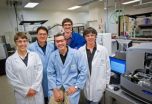(Press-News.org) A type of haemorrhagic fever that is prevalent in Africa, Asia, and the Balkans has begun to spread to new areas in southern Europe. Now Swedish researchers have shown that migratory birds carrying ticks are the possible source of contagion. The discovery is being published in the US journal Emerging Infectious Diseases.
Crimean-Congo Haemorrhagic fever is a serious disease that begins with influenza-like symptoms but can develop into a very serious condition with high mortality (30%). The disease occurs in Africa, Asia, and the Balkans but it has recently started to spread to new areas in southern Europe. It is caused by a virus that is spread by tick bites and common host animals are various small mammals and ungulates. Humans are infected by tick bites or close contact with contagious mammals.
Researchers have now studied the dissemination mechanisms of this potentially fatal disease. The study is multidisciplinary, with bird experts, tick experts, molecular biologists, virologists, and infectious disease physicians from Uppsala University and Uppsala University Hospital in collaboration with colleagues from the Swedish Institute for Communicable Disease Control, Kalmar and Linköping. Ornithologists and volunteers also helped gather birds.
During two spring seasons in 2009-2010, a total of 14,824 birds were captured at the two ornithological stations Capri (Italy) and Anticythera (Greece), on their way from Africa to Europe. A total of 747 ticks were gathered and analysed for the virus.
Some 30 different bird species were examined, and one species, the woodchat shrike, which winters in southern Africa and nests in Central Europe, proved to be a carrier of virus-infected ticks.
'This is the first time ticks infected with this virus have been found on migratory birds. This provides us with an entirely new explanation of how this disease, as well as other tick-borne diseases, has spread to new areas, where new mammal populations can be infected by the infected ticks', says Erik Salaneck, one of the authors of the study.
The Hyalomma tick, which spreads the disease, does not thrive in northern Europe, preferring warmer latitudes. But with a warmer climate, the boundary for both the tick species and the disease could move northward with the help of migratory birds.
### The article will appear in print in December.
Migratory birds can spread haemorrhagic fever
2012-10-23
ELSE PRESS RELEASES FROM THIS DATE:
Low adoption by large hospital ICUs of catheter-associated urinary tract infection precautions
2012-10-23
NEW YORK –Hospital size matters when it comes to intensive care units (ICUs) adopting even the most routine prevention policies for catheter-associated urinary tract infections (CAUTI), according to a new study from researchers at Columbia University School of Nursing, published this month in the American Journal of Infection Control. The study found that large hospitals -- those with more than 500 beds --had a 1.5 higher average rate of CAUTI than hospitals with 500 beds or less. Since larger hospitals, particularly teaching hospitals treat patients who are often sicker, ...
Tiny pores in graphene could give rise to membranes
2012-10-23
CAMBRIDGE, Mass. — Much has been made of graphene's exceptional qualities, from its ability to conduct heat and electricity better than any other material to its unparalleled strength: Worked into a composite material, graphene can repel bullets better than Kevlar. Previous research has also shown that pristine graphene — a microscopic sheet of carbon atoms arranged in a honeycomb pattern — is among the most impermeable materials ever discovered, making the substance ideal as a barrier film.
But the material may not be as impenetrable as scientists have thought. By engineering ...
Are schizophrenia and autism close relations?
2012-10-23
Autism Spectrum Disorders (ASD), a category that includes autism, Asperger Syndrome, and Pervasive Developmental Disorder, are characterized by difficulty with social interaction and communication, or repetitive behaviors. The U.S. Centers for Disease Control and Management says that one in 88 children in the US is somewhere on the Autism spectrum — an alarming ten-fold increase in the last four decades.
New research by Dr. Mark Weiser of Tel Aviv University's Sackler Faculty of Medicine and the Sheba Medical Center has revealed that ASD appears share a root cause with ...
NASA sees active region on the sun emit another flare
2012-10-23
VIDEO:
Video of the Oct. 22, 2012, solar flare as captured by NASA's Solar Dynamics Observatory in the 131 and 304 Angstrom wavelengths. LINK TO HIGHEST RESOLUTION VIDEO: ...
Quasar may be embedded in unusually dusty galaxy
2012-10-23
Hubble astronomers have looked at one of the most distant and brightest quasars in the universe and are surprised by what they did not see: the underlying host galaxy of stars feeding the quasar. The best explanation is that the galaxy is shrouded in so much dust that the stars are completely hidden everywhere. Astronomers believe that the James Webb Space Telescope will reveal the galaxy.
All but the very first galaxies contain some dust—the early universe was dust-free until the first generation of stars started making dust through nuclear fusion. As these stars aged ...
Is declining medical imaging use driving up hospital stays and medical costs?
2012-10-23
A new report by the Harvey L. Neiman Health Policy Institute shows that the length of the average hospital stay in the United States has increased at the same time as use of medical imaging scans has declined. It is unclear if the trends are related, but potentially important, as hospital admissions are among the largest, and fastest growing, health care costs. More research is needed to assess the potential negative impact of government and private insurer imaging reductions on overall medical costs and patient safety.
"Lawmakers, regulators and medical professionals ...
Making transport a driver for development in Africa
2012-10-23
A new report by a panel of international experts highlights policies to improve air quality road safety and congestion, supporting African development.
Transport is playing a big role in delivering economic development to Africa. But as the demand for transport grows and cities expand, policy makers need to tackle transport challenges to make sure that all parts of society can benefit from this central driver of jobs and growth.
"Transport policies in Africa are of critical importance to the delivery of sustainable cities, healthy citizens and poverty eradication," ...
Training your robot the PaR-PaR way
2012-10-23
Teaching a robot a new trick is a challenge. You can't reward it with treats and it doesn't respond to approval or disappointment in your voice. For researchers in the biological sciences, however, the future training of robots has been made much easier thanks to a new program called "PaR-PaR."
Nathan Hillson, a biochemist at the U.S. Department of Energy (DOE)'s Joint BioEnergy Institute (JBEI), led the development of PaR-PaR, which stands for Programming a Robot. PaR-PaR is a simple high-level, biology-friendly, robot-programming language that allows researchers to ...
Study explains connection between Hawaii's dueling volcanoes
2012-10-23
HOUSTON -- (Oct. 23, 2012) -- A new Rice University-led study finds that a deep connection about 50 miles underground can explain the enigmatic behavior of two of Earth's most notable volcanoes, Hawaii's Mauna Loa and Kilauea. The study, the first to model paired volcano interactions, explains how a link in Earth's upper mantle could account for Kilauea and Mauna Loa's competition for the same deep magma supply and their simultaneous "inflation," or bulging upward, during the past decade.
The study appears in the November issue of Nature Geoscience.
The research offers ...
Oxygen's ups and downs in the early atmosphere and ocean
2012-10-23
RIVERSIDE, Calif. — Most researchers imagine the initial oxygenation of the ocean and atmosphere to have been something like a staircase, but with steps only going up. The first step, so the story goes, occurred around 2.4 billion years ago, and this, the so-called Great Oxidation Event, has obvious implications for the origins and evolution of the first forms of eukaryotic life. The second big step in this assumed irreversible rise occurred almost two billion years later, coinciding with the first appearances and earliest diversification of animals.
Now a team led ...




